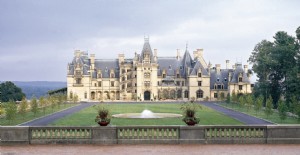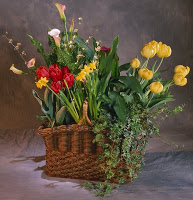Biltmore House, the 250-room French Renaissance chateau located in Asheville, NC, was built in the late 1800s as the country retreat of George and Edith Vanderbilt. The Vanderbilts commissioned Frederick Law Olmsted, the father of landscape architecture in America, to design the grounds.
Probably best known as the landscape architect of Central Park in New York, gentleness, charm and naturalness are keynotes of Olmsted’s style. If creating your own park based on Olmsted’s principals isn’t going to happen, why not try creating a miniature Olmsted landscape — an Olmsted Basket.
Creating An Olmsted Basket
The picturesque and pastoral elements of Olmsted’s gardens can be a charming miniature landscape. To create this small garden you must first choose a container, plant materials, and accessories that compliment each other and your setting.
- Containers
- Can be a basket, ceramic bowl, brass dish or wooden box; anything deep enough to hide the pots and give you room to create.
- If you use an open weave basket, line it first with sphagnum moss so the foil and mechanics won’t show.
- Plant material
- Choose plants with similar requirements such as light, water, humidity, and temperature.
- Use both tall and low plants, some upright and some spreading or vining to add interest or depth.
- The size of the plant or pot is determined by the size of your container; 4″ pots are easy to handle and to keep watered. Pots of various sizes can be mixed but will change the ease of care.
- All pots should have drainage holes; soggy roots will rot.
- Accessories
- Use natural materials; nests, rocks, bark, twigs, lichens, gourds, berries.
- Be creative! Consider where the arrangement will be placed; buffet – candles or fruit; table – ornaments or figurines.
Steps for designing your Olmsted Basket:
- Soak all plant materials well and allow to drain.
- Line the basket carefully with florists’ polyfoil. This foil is moldable and has a plastic coating on one side. Use two layers of foil (wicker can punch a hole in the foil) to create a watertight container.
- Use floral foam (oasis) to stack and wedge the pots into position. The foam will not only secure the pots but will absorb the water that drains from pots and will raise the humidity.
- Arrange the plants in an uncontrived manner, You want to achieve a rambling, natural, simple feeling. Don’t crowd and remember to vary height or depth of pots in the container.
- Consider ease of watering when placing the pots. If too close to the edge of the container, water could spill over. Pots close to the edge should be slightly lower than the edge of the container. Plants toward the center can be elevated since run off water will be caught in the container or liner.
- Place moss over all oasis and pots to cover your mechanics. Create interest with mosses by using different textures. You may use dried or living mosses. Brush moss debris from foliage with a small paintbrush.
- Put your Olmsted Basket in place and accessorize!
- Water with care as required by each pot; feel the soil. Some plants may need to be removed for watering or to be replaced. Just pull out, water, replace and remoss.
Notes:
Remember, these small landscapes are for indoors. Rain could drown your work. The pots have drainage but the basket does not!



